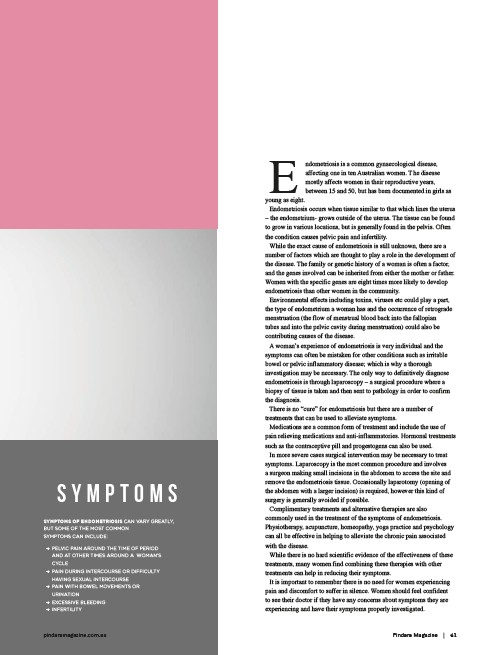
Endometriosis is a common gynaecological disease,
affecting one in ten Australian women. The disease
mostly affects women in their reproductive years,
between 15 and 50, but has been documented in girls as
young as eight.
Endometriosis occurs when tissue similar to that which lines the uterus
– the endometrium- grows outside of the uterus. The tissue can be found
to grow in various locations, but is generally found in the pelvis. Often
the condition causes pelvic pain and infertility.
While the exact cause of endometriosis is still unknown, there are a
number of factors which are thought to play a role in the development of
the disease. The family or genetic history of a woman is often a factor,
and the genes involved can be inherited from either the mother or father.
Women with the specific genes are eight times more likely to develop
endometriosis than other women in the community.
Environmental effects including toxins, viruses etc could play a part,
the type of endometrium a woman has and the occurrence of retrograde
menstruation (the flow of menstrual blood back into the fallopian
tubes and into the pelvic cavity during menstruation) could also be
contributing causes of the disease.
A woman’s experience of endometriosis is very individual and the
symptoms can often be mistaken for other conditions such as irritable
bowel or pelvic inflammatory disease; which is why a thorough
investigation may be necessary. The only way to definitively diagnose
endometriosis is through laparoscopy – a surgical procedure where a
biopsy of tissue is taken and then sent to pathology in order to confirm
the diagnosis.
There is no “cure” for endometriosis but there are a number of
treatments that can be used to alleviate symptoms.
Medications are a common form of treatment and include the use of
pain relieving medications and anti-inflammatories. Hormonal treatments
such as the contraceptive pill and progestogens can also be used.
In more severe cases surgical intervention may be necessary to treat
symptoms. Laparoscopy is the most common procedure and involves
a surgeon making small incisions in the abdomen to access the site and
remove the endometriosis tissue. Occasionally laparotomy (opening of
the abdomen with a larger incision) is required, however this kind of
surgery is generally avoided if possible.
Complimentary treatments and alternative therapies are also
commonly used in the treatment of the symptoms of endometriosis.
Physiotherapy, acupuncture, homeopathy, yoga practice and psychology
can all be effective in helping to alleviate the chronic pain associated
with the disease.
While there is no hard scientific evidence of the effectiveness of these
treatments, many women find combining these therapies with other
treatments can help in reducing their symptoms.
It is important to remember there is no need for women experiencing
pain and discomfort to suffer in silence. Women should feel confident
to see their doctor if they have any concerns about symptoms they are
experiencing and have their symptoms properly investigated.
S Y M P T O M S
SYMPTOMS OF ENDOMETRIOSIS CAN VARY GREATLY,
BUT SOME OF THE MOST COMMON
SYMPTOMS CAN INCLUDE:
PELVIC PAIN AROUND THE TIME OF PERIOD
AND AT OTHER TIMES AROUND A WOMAN’S
CYCLE
PAIN DURING INTERCOURSE OR DIFFICULTY
HAVING SEXUAL INTERCOURSE
PAIN WITH BOWEL MOVEMENTS OR
URINATION
EXCESSIVE BLEEDING
INFERTILITY
pindaramagazine.com.au Pindara Magazine | 41